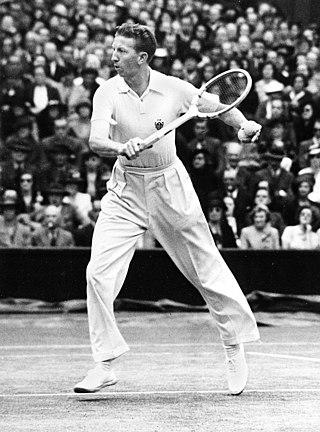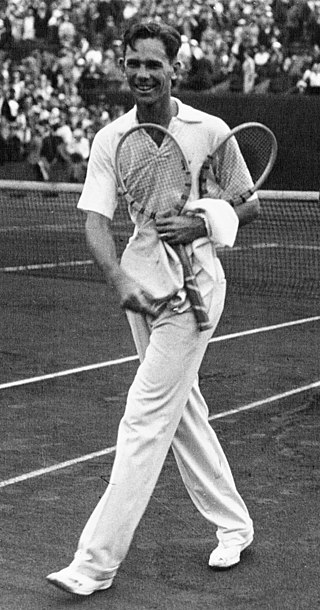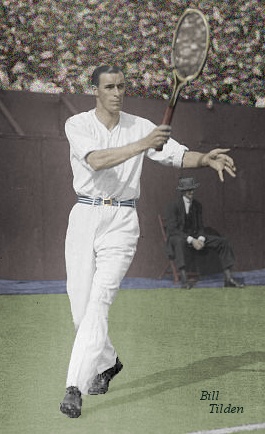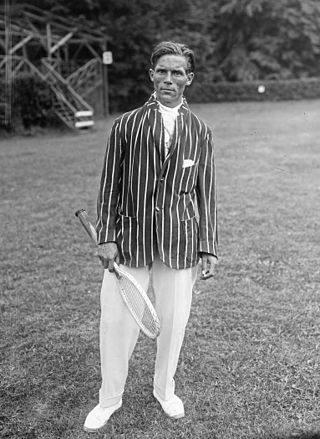
Rodney George Laver is an Australian former tennis player. Laver was ranked the world number 1 professional player indisputably for five years from 1965 to 1969 and by some sources also in 1964 and 1970. He was also ranked as the number 1 amateur in 1961 and 1962. Laver won 198 singles titles which is the most won by a player in history.

John Donald Budge was an American tennis player. He is most famous as the first tennis player — male or female, to win all four Grand Slam events consecutively overall. Budge was the second man to complete the career Grand Slam after Fred Perry, and remains the youngest to achieve the feat. He won ten majors, of which six were Grand Slam events and four Pro Slams, the latter achieved on three different surfaces. Budge is considered to have one of the best backhands in the history of tennis, with most observers rating it better than that of later player Ken Rosewall.

Frederick John Perry was a British tennis and table tennis player and former world No. 1 from England who won 10 Majors including eight Grand Slam tournaments and two Pro Slams single titles, as well as six Major doubles titles. Perry won three consecutive Wimbledon Championships from 1934 to 1936 and was World Amateur number one tennis player during those three years. Prior to Andy Murray in 2013, Perry was the last British player to win the men's Wimbledon championship, in 1936, and the last British player to win a men's singles Grand Slam title, until Andy Murray won the 2012 US Open.

Lewis Alan Hoad was an Australian tennis player whose career ran from 1950 to 1973. Hoad won four Major singles tournaments as an amateur. He was a member of the Australian team that won the Davis Cup four times between 1952 and 1956. Hoad turned professional in July 1957. He won the Kooyong Tournament of Champions in 1958 and the Forest Hills Tournament of Champions in 1959. He won the Ampol Open Trophy world series of tournaments in 1959, which included the Kooyong tournament that concluded in early January 1960. Hoad's men's singles tournament victories spanned from 1951 to 1971.

Ricardo Alonso "Pancho" González, known sometimes as Richard Gonzales, was an American tennis player. He won 15 major singles titles, including two U.S. National Singles Championships in 1948 and 1949, and 13 Professional Grand Slam titles. He also won three Tournament of Champions professional events in 1957, 1958, and 1959. He was ranked world amateur No. 1 in 1948 by Ned Potter and in 1949 by Potter and John Olliff.

John Albert Kramer was an American tennis player of the 1940s and 1950s, and a pioneer promoter who helped drive the sport towards professionalism at the elite level. Kramer also ushered in the serve-and-volley era in tennis, a playing style with which he won three Grand Slam tournaments. He also led the U.S. Davis Cup tennis team to victory in the 1946 and 1947 Davis Cup finals.

Henry Ellsworth Vines Jr. was an American tennis champion of the 1930s, the World No. 1 player or the co-No. 1 in 1932 as an amateur, and in 1934, 1935, 1936 and 1937 as a professional. He won three Grand Slam titles, the U.S. National Championships in 1931 and 1932 and the Wimbledon Championships in 1932. Vines also was able to win Pro Slam titles on three different surfaces. He later became a professional golfer and reached the semifinals of the PGA Championship in 1951.

William Tatem Tilden II, nicknamed "Big Bill", was an American tennis player. Tilden was the world No. 1 amateur for six consecutive years, from 1920 to 1925, and was ranked as the world No. 1 professional by Ray Bowers in 1931 and 1932 and Ellsworth Vines in 1933. He won 14 Major singles titles, including 10 Grand Slam events, one World Hard Court Championships and three professional majors. He was the first American man to win Wimbledon, taking the title in 1920. He also won a joint-record seven U.S. Championships titles.

Henri Jean Cochet was a French tennis player. He was a world No. 1 ranked player, and a member of the famous "Four Musketeers" from France who dominated tennis in the late 1920s and early 1930s.
Before the advent of the Open era of tennis competitions in April 1968, only amateurs were allowed to compete in established tournaments, including the four majors. There was no prize money and players were compensated for travel expenses only. However many top tennis players turned professional to play legally for prize money in the years before the open era. They played in separate professional events, mostly on tours involving head-to-head competition, but also in professional tournaments as the biggest events on the pro tour. Professional tournaments, in particular the professional majors, usually only had a men's draw.
Hans "Hanne" Nüsslein was a German tennis player and coach and former World professional number 1 tennis player who won four professional Majors singles titles during his career.

Karel Koželuh was a Czech tennis, association football, and ice hockey player of the 1920s and 1930s. Koželuh became a European ice hockey champion in 1925 and was one of the top-ranked players on the professional tennis circuit in the 1930s.

Vincent Richards was an American tennis player. He was active in the early decades of the 20th century, particularly known as being a superlative volleyer. He was ranked World No. 2 as an amateur in 1924 by A. Wallis Myers, and was ranked joint World No. 1 pro by Ray Bowers in 1927 and World No. 1 pro by Bowers in 1930.
Frank Kovacs was an American amateur and professional tennis player in the mid-20th century. He won the U.S. National Indoor Tennis Championships singles title in 1941. He won the World Professional Championships tournament in 1945 in San Francisco. Kovacs was successful on clay and won the Great Lakes Professional Clay Court Championships near Chicago in 1946, defeating Riggs in the final, and five U.S. Professional Clay Court Championships from 1948 to 1953. Kovacs won U.S. Professional Championships or International Professional Championships at Cleveland in 1951. He also won the U.S. Professional Challenge Tour in 1947 against Bobby Riggs.
World number 1 ranked male tennis players is a year-by-year listing of the male tennis players who were ranked as world No. 1 by various contemporary and modern sources. The annual source rankings from which the No. 1 players are drawn are cited for each player's name, with a summary of the most important tennis events of each year also included. If world rankings are not available, recent rankings by tennis writers for historical years are accessed, with the dates of the recent rankings identified. In the period 1948–1953, when contemporary professional world rankings were not created, the U.S. professional rankings are cited.
This article is concerned with the major tennis achievements of tennis male players of all tennis history.
The Wembley Championships was a men's professional tennis tournament held from 1934–1990 with some periods of inactivity in between and is often considered to be one of the three major professional tennis tournaments from 1927–1967 until the advent of the open era. Ken Rosewall's and Rod Laver's six singles titles are the record for this event. The tournament only had a men's draw.
The French Pro Championship was a major tennis tournament founded in 1930 by the "Association Française des Professeurs de Tennis (AFPT)" and ran annually until 1968 when it was discontinued.
Robert Ramillon was a French professional tennis player of the 1930s and was the winner of French Pro in 1932. He also played in the finals in 1931 and 1936.
This article presents top ten lists of male singles tennis players, as ranked by various official and non-official ranking authorities throughout the history of the sport. Rankings of U.S.-only professionals pre-Open Era, and U.S.-only amateurs during World War II are also included.










